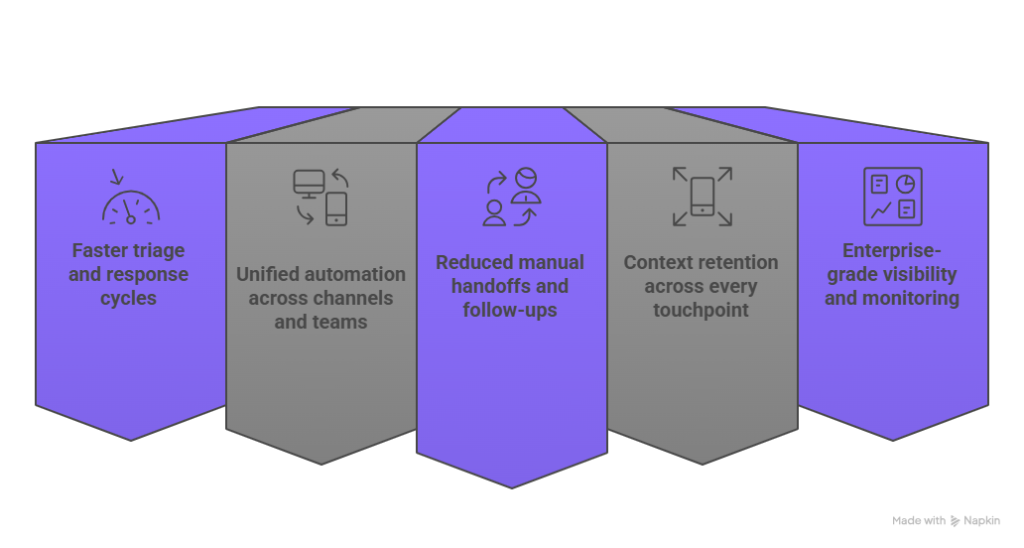A conversation rarely lives in one channel anymore.
A supplier sends a quote by email, the procurement team follows up on WhatsApp, and the final approval happens over a quick Teams call. Each of these interactions matters, but too often, they live in silos. The context that should flow freely across them gets lost somewhere between the inbox and the chat window.
For most enterprises, this is the new normal. Systems built for efficiency now operate in isolation, forcing teams to bridge gaps manually. That’s where omnichannel AI automation becomes critical as an approach that unifies Email, WhatsApp, Teams, Voice, and other channels into a single connected experience.
At the heart of this lies omnichannel communication AI intelligence that understands user intent, tracks context across touchpoints, and ensures every interaction feels consistent and timely. DTskill’s GenE AI orchestration brings this to life through a robust AI orchestration platform designed for large-scale, enterprise AI automation.
By combining workflows, data, and intent recognition across tools, GenE delivers true cross-channel AI integration that adapts to enterprise operations, whether in customer support, procurement, or internal collaboration. It enables AI automation for enterprises that’s both intelligent and context-aware, setting a new standard for AI for customer service automation and beyond.
In the next section, we’ll look at why achieving this level of seamless orchestration remains a challenge and what it takes to overcome it.
The Challenge
Most enterprises don’t struggle with communication; they struggle with connection.
Across Email, WhatsApp, Teams, and Voice, messages move faster than ever, but the context behind them often doesn’t. Every channel works well individually, yet collectively, they create fragmentation that slows down decisions and blurs accountability.
Three core challenges define this gap:

- Disjointed Workflows: Each channel operates on its own logic; a customer issue discussed on Teams may not sync with what’s logged in email or chat.
- Lost Context: Agents or teams lack visibility into the full journey, forcing them to repeat questions or retrace interactions.
- Inconsistent Automation: AI solutions built for one channel rarely extend to others, leaving enterprises with multiple isolated bots instead of a unified system.
At scale, these inefficiencies compound. A procurement request routed through email might miss supplier updates in WhatsApp. A voice query answered by one department may never reach another that needs the data. The result? Delays, duplication, and dissatisfied customers are not because teams are inefficient, but because the system itself isn’t connected.
That’s where omnichannel AI automation becomes essential, not as another tool, but as a strategic layer that synchronizes intelligence across every communication path.
To make that possible, enterprises need more than automation; they need orchestration.
A purpose-built AI orchestration platform like GenE AI orchestration ensures every message, request, and workflow flows seamlessly across channels through unified omnichannel communication AI.
Because when intelligence moves with context, communication finally becomes connection.
What Omnichannel AI Means
Most enterprises have automation, but in pieces. A chatbot for service, an email responder for support, and a voice system for queries. Each works well, but together, they lack continuity. True AI automation for enterprises connects these fragments into one intelligent flow.
Omnichannel AI ensures context travels with every interaction from email to WhatsApp to Teams to voice. That’s the essence of enterprise AI automation: every touchpoint speaking the same language.
Through cross-channel AI integration, systems don’t just exchange data; they share understanding. It’s what allows AI for customer service automation to move beyond responses into continuous, context-rich conversations.
How GenE Powers Omnichannel Automation
True omnichannel AI automation isn’t about adding more bots to different systems; it’s about creating a single, coordinated layer that lets them work together intelligently. That’s the role of GenE AI orchestration to unify automation, maintain context, and deliver consistency across every enterprise communication channel.

a. Orchestrates Modular AI Agents
Within GenE, every agent is designed for a specific function, auto-replying to customer emails, routing messages to the right department, summarizing calls, or executing predefined actions in ERP or CRM systems. GenE coordinates these agents so they operate as one ecosystem, where each task completed by one agent instantly informs the next. This architecture makes AI orchestration platform capabilities tangible, not theoretical, by linking logic, data, and execution under one roof.
b. Integrates Across All Channels & Systems
GenE connects with existing enterprise infrastructure, Email servers, WhatsApp Business API, Microsoft Teams, Voice IVRs, CRMs, ERPs, and ticketing platforms, ensuring AI automation for enterprises works natively within the tools teams already use. There’s no need to rebuild systems; GenE integrates through APIs and connectors to unify how information moves, ensuring every inquiry, order, or request is tracked and resolved without losing context between channels.
c. LLM + Vector DB Agnostic
GenE’s flexible design allows it to integrate with any large language model (GPT, Claude, LLaMA) and vector database (Pinecone, Weaviate, Qdrant). This means enterprises can choose the best model for their data and needs without being tied to one vendor. The result is agility, the ability to evolve AI systems as technology advances, while keeping a stable orchestration layer that anchors consistency and scale.
d. Centralized AI Lifecycle Management
Every AI action, from prompt retrieval and response generation to validation and execution, is centrally managed within GenE. This allows enterprises to monitor performance, trace decisions, and refine behavior across all communication channels. Over time, this continuous feedback loop strengthens reliability and ensures automation aligns with enterprise-grade standards for accuracy, compliance, and governance.
→ Enterprise Impact:
- Consistent experiences across customer, supplier, and employee interactions
- Reduced manual routing and coordination between teams
- Real-time data exchange across interconnected systems
- Measurable visibility into AI workflows and outcomes
Functional Use Cases
| Department | Current Scenario | Solution | Impact |
| Procurement | Procurement teams manage countless supplier emails, quotes, and order updates across disconnected tools. Manual follow-ups slow down approvals and create blind spots. | With GenE AI orchestration, supplier messages are auto-categorized, verified, and synced directly with ERP systems. GenE agents track orders, match invoices, and keep supplier data current in real time. | Shorter purchase cyclesTransparent supplier coordinationFewer manual touchpoints |
| Sales | Sales teams juggle leads and conversations across Email, WhatsApp, Teams, and CRM systems, often losing context between touchpoints. | Through omnichannel AI automation, GenE connects all channels, generates conversation summaries, and auto-updates CRMs. Every rep sees the full customer thread and can act instantly. | Faster deal closuresHigher conversion accuracyUnified customer visibility |
| Finance | Finance teams spend hours verifying invoices and matching purchase orders across email and accounting tools. Errors and delays accumulate. | Using AI automation for enterprises, GenE automates validation, escalation, and ledger updates across ERP systems. Transactions move seamlessly from receipt to reconciliation. | Quicker financial processingReduced manual verificationAudit-ready accuracy |
| Operations | Operational workflows rely on disconnected tools for planning, communication, and reporting, causing misalignment and delays. | GenE enables cross-channel AI integration, syncing data and updates across Teams, voice, and ERP systems. A single update triggers coordinated actions across functions. | Real-time operational visibilityAutomated task synchronizationFewer workflow disruptions |
| IT & Support | IT and support teams face repetitive tickets and voice requests spread across multiple systems with no shared context. | With AI for customer service automation, GenE classifies, routes, and summarizes tickets across chat, voice, and email for consistent handling. | Faster query resolutionConsistent cross-channel responsesHigher agent efficiency |
Enterprise-Wide Outcome
When GenE AI orchestration connects every communication channel and workflow, the outcome isn’t just automation, it’s synchronization. Enterprises gain a cohesive digital fabric where every message, task, and decision moves fluidly across teams and systems.
Through omnichannel AI automation, responses become faster, actions more precise, and visibility sharper. This connected structure forms the backbone of enterprise AI automation, driving scalable intelligence, effortless collaboration, and lasting operational resilience.
Key Outcomes:

- Faster triage and response cycles
- Unified automation across channels and teams
- Reduced manual handoffs and follow-ups
- Context retention across every touchpoint
- Enterprise-grade visibility and monitoring
In essence, Omnichannel communication AI powered by GenE transforms scattered communication into a connected network of intelligence where every interaction drives measurable enterprise value.
Conclusion
Enterprises don’t just need more channels; they need connected intelligence across them. With GenE AI orchestration, every communication touchpoint from Email and WhatsApp to Teams and Voice becomes part of a single, cohesive system.
It’s not about replacing tools; it’s about aligning them to think and act together. Through omnichannel AI automation, GenE bridges silos, maintains context, and ensures that every response, whether to a customer, supplier, or employee, carries the same accuracy and speed.
This is the future of enterprise communication: intelligent, consistent, and orchestrated.With DTskill, that future is already in motion, one connection powering infinite automation.
